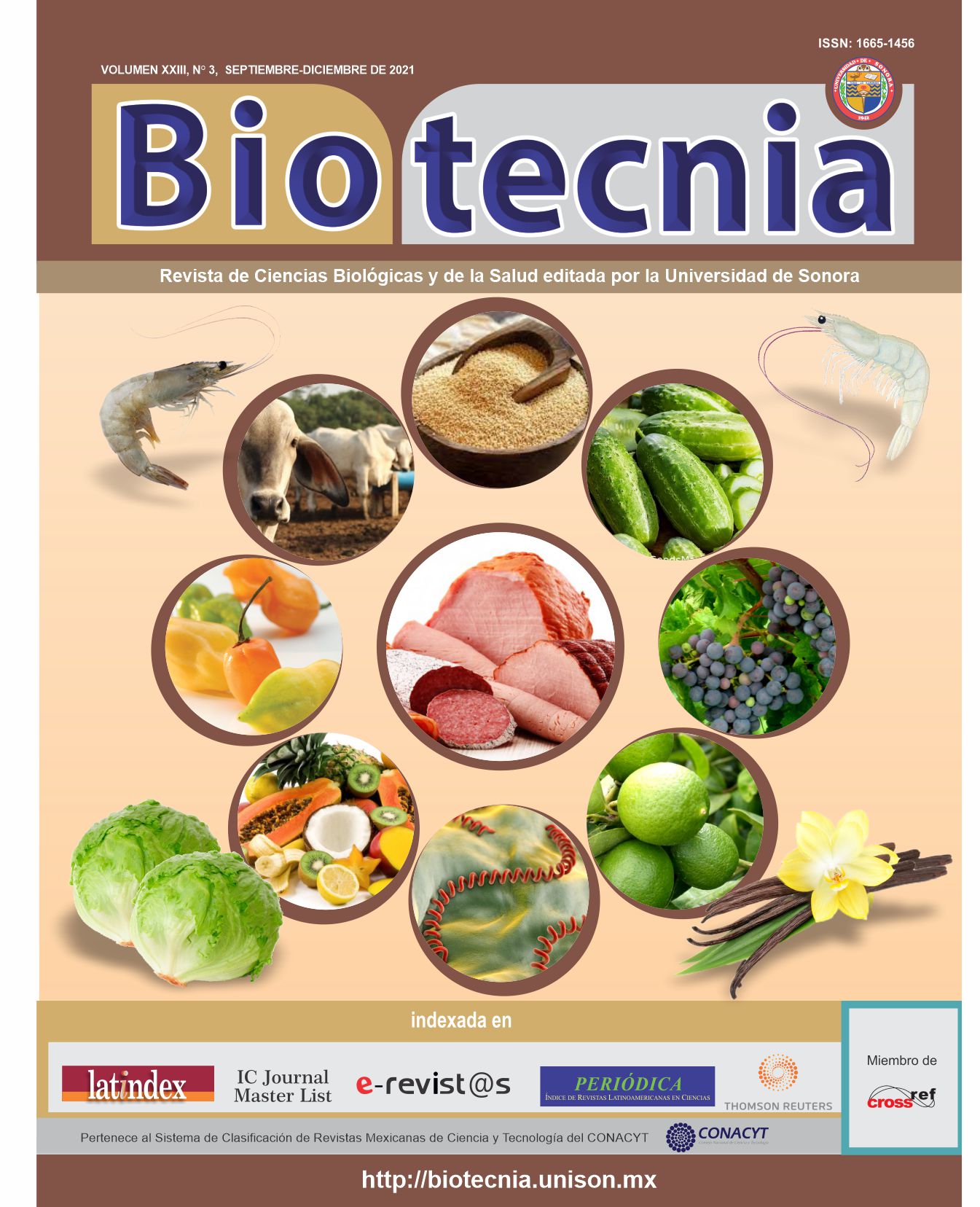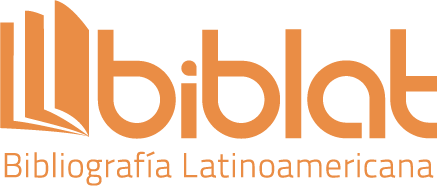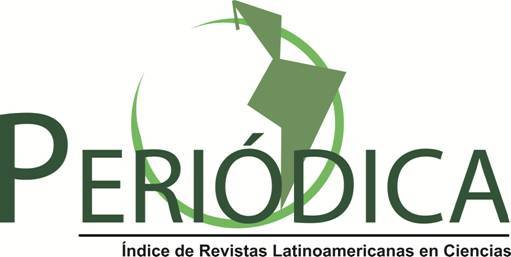Frecuencia, distribución territorial y resistencia a los antimicrobianos de Salmonella spp. aislada de heces de ganado bovino de la región Altos Sur en el estado de Jalisco, México
DOI:
https://doi.org/10.18633/biotecnia.v23i3.1371Keywords:
Salmonella spp., Bovine cattle feces, Multidrug-resistant strain, Altos Sur region of Jalisco StateAbstract
Multidrug resistance is a global public health problem. In 2017, in Mexico, Salmonella caused 192,771 foodborne zoonosis cases. Sonora, Hidalgo, Mexico State and Jalisco have reports of multi-resistant Salmonella strains in chicken and beef carcasses in slaughterhouses; however, the prevalence in livestock herds is unknown. From January 2012 to October 2013, 144 diarrheal stool samples were collected from bovine hatchlings from the Altos Sur region of the Jalisco State. As a result, the presence and serotype of Salmonella was determined, as well as the antibiotic resistance profile, and the genetic relationship, using PFGE. The Salmonella prevalence was 4.16 % (6/144) in feces, identifying the serotypes Anatum, Pullorum, Poona, Typhi, Gallinarum and Salmonella enterica subsp. arizonae. All the strains showed resistance to ampicillin, cephalothin, trimethoprim-sulfamethoxazole, and some of them, additionally, to amikacin, cefotaxime and/or ceftriaxone. In addition, the persistence and potential spread of two Salmonella Anatum strains was discovered in one herd. This is the first study conducted in neonate bovine in the Jalisco State, Mexico, to detect multidrug resistant Salmonella. Continuous monitoring of multi-drug resistance in animal biota for human food and ongoing training of veterinary doctors are key elements for efficient prophylaxis and antimicrobial pharmacotherapy.
Downloads
References
Aidara-Kane, A., Angulo, F.J., Conly, J.M., Minato, Y., Silbergeld, E.K., McEwen, S.A., & Collignon, P.J. 2018. World Health Organization (WHO) guidelines on use of medically important antimicrobials in food-producing animals. Antimicrobial Resistance & Infection Control, 7(1): 7.
Arthur, T.M., Kalchayanand, N., Bosilevac, J.M., Brichta-Harhay, D.M., Shackelford, S.D., Bono, J.L., Wheeler, T.L. & Koohmaraie, M. 2008. Comparison of effects of antimicrobial interventions on multidrug-resistant Salmonella, susceptible Salmonella, and Escherichia coli O157: H7. Journal of food protection, 71(11): 2177-2181.
Barkocy-Gallagher, G.A., Arthur, T.M., Rivera-Betancourt, M., Nou, X., Shackelford, S.D., Wheeler, T.L., & Koohmaraie, M. 2003. Seasonal prevalence of Shiga toxin–producing Escherichia coli, including O157: H7 and non-O157 serotypes, and Salmonella in commercial beef processing plants. Journal of food protection, 66(11): 1978-1986.
Callaway, T.R., Edrington, T.S., Anderson, R.C., Byrd, J.A. & Nisbet, D.J. 2008. Gastrointestinal microbial ecology and the safety of our food supply as related to Salmonella. Journal of Animal Science. 86:E163–E172.
Camacho, R.O., Acedo, R.L.E., Moreno, I.G.M., Sánchez, M.R.I., Castillón, C.L.G. & Navarro, N.M. 2010. Detección de Salmonella resistente a los antibióticos en vísceras de pollo. Biotecnia. XII: 3-11.
CDC, 2009. Centers for Disease Control and Prevention. National Center for Emerging and Zoonotic Infectious Diseases (NCEZID), Division of Foodborne, Waterborne, and Environmental Diseases (DFWED). Available at: https://www.cdc.gov/salmonella/general/technical.html. Accessed July 2013.
CLSI. 2009. M2-A10. Performance standards for antimicrobial disk susceptibility test. 10th ed. Clinical and Laboratory Standards Institute. (Updated standard available at: www.clsi.org.) Wayne, Pennsylvania. USA.
CLSI. 2010. M100-S20. Performance standards for antimicrobial susceptibility testing. 20th ed. Clinical and Laboratory Standards Institute. Wayne, Pennsylvania. USA. Available at: https://www.techstreet.com/mss/products/preview/1662926. Accessed March 2013.
COMECARNE. 2017. Consejo Mexicano de la Carne, con datos del INEGI. Compendio estadístico 2017 de la industria cárnica mexicana. Available at: http://comecarne.org/wp-content/uploads/2018/05/Compendio-Estad%C3%ADstico-2017-v7-1-sin-elab.pdf. Accessed November 2018.
Duggan, S., Jordan, E., Gutierrez, M., Barrett, G., O’Brien, T., Hand, D. & Egan, J. 2012. Salmonella in meats, water, fruit and vegetables as disclosed from testing undertaken by Food Business Operators in Ireland from 2005 to 2009. Irish veterinary journal, 65(1): 17.
Elder, R.O., Keen, J.E., Siragusa, G.R., Barkocy-Gallagher, G.A., Koohmaraie, M., & Laegreid, W.W. 2000. Correlation of enterohemorrhagic Escherichia coli O157 prevalence in feces, hides, and carcasses of beef cattle during processing. Proceedings of the National Academy of Sciences. 97(7): 2999-3003.
Evangelopoulou, G., Kritas, S., Govaris, A., & Burriel, A.R. 2014. Pork meat as a potential source of Salmonella enterica subsp. arizonae infection in humans. Journal of clinical microbiology, 52(3): 741-744.
FAOSTAT. 2017. FAOSTAT México. Organización de las Naciones Unidas para la Agricultura y la Alimentación. Available at: http://www.fao.org/faostat/en/#data/CL. Accessed November 2018.
FDA. (2010a). Food and Drug Administration. Guidance for Industry-Studies to Evaluate the Safety of Residues of Veterinary Drugs in Human Food: General Approach to Establish a Microbiological ADI VICH GL36(R) Available at https://www.fda.gov/downloads/AnimalVeterinary/GuidanceComplianceEnforcement/GuidanceforIndustry/UCM124674.pdf . Accessed November, 2018.
FDA. (2010b). Food and Drug Administration. CVM Updates - CVM Reports on Antimicrobials Sold or Distributed for Food-Producing Animals (Food Drug Admin, Silver Spring. MD). Available at www.fda.gov/AnimalVeterinary/NewsEvents/CVMUpdates/ucm236143.htm. Accessed March 2015.
Geimba, M.P., Tondo, E.C., de Oliveira, F.A., Canal, C.W., & Brandelli, A. 2004. Serological characterization and prevalence of spvR genes in Salmonella isolated from foods involved in outbreaks in Brazil. Journal of food protection. 67(6): 1229-1233.
Geornaras, I., Yang, H., Moschonas, G., Nunnelly, M.C., Belk, K.E., Nightingale, K.K., & Sofos, J.N. 2012. Efficacy of chemical interventions against Escherichia coli O157: H7 and multidrug-resistant and antibiotic-susceptible Salmonella on inoculated beef trimmings. Journal of food protection. 75(11): 1960-1967.
Gordillo Benavente, M.A. 2019. Prevalencia de Salmonella spp. en alimentos contaminados y descripción según serotipos; tipos de alimentos y jurisdicciones sanitarias afectadas en Chiapas, durante el periodo 2016-2018 (Doctoral dissertation, Facultad en Ciencias Odontológicas y Salud Pública-Maestría en Ciencias en Salud Pública-UNICACH). México State, México.
Gould, D., Kraa, E., Dalton, C. B., Givney, R., Gregory, J., Stafford, R.J., & Kirk, M.D. 2004. Foodborne disease outbreaks in Australia, 1995 to 2000. Communicable diseases intelligence quarterly report: 28(2): 211.
Holschbach, C.L., & Peek, S.F. 2018. Salmonella in dairy cattle. Veterinary Clinics of North America: Food Animal Practice. 34: 133– 154.
Hughes, D., Dailianis, A.E., Hill, L., Curiale, M.S. & Gangar, V. 2003. Salmonella in foods: new enrichment procedure for TECRA Salmonella visual immunoassay using a single rv(R10) only, TT only, or dual rv(R10) and TT selective enrichment broths (AOAC official method 998.09): collaborative study. J. AOAC Int. 86: 775–790.
IIEG. 2019. Instituto de Información Estadística y Geográfica del Estado de Jalisco. Diagnóstico de la región Altos Sur Agosto 2019. Available at: https://iieg.gob.mx/ns/wp-content/uploads/2019/12/03-Altos-Sur-Diagn%C3%B3stico-1.pdf . Accessed July 2020.
Kauffman, G. 1974. “Kauffman White Scheme. WHO. Pd 172, 1, rev. 1,” Acta Pathologica et Microbiologica Scandinavica Section B-Microbiology. 61: 385.
Laxminarayan, R., Duse, A., Wattal, C., Zaidi, A.K., Wertheim, H.F., Sumpradit, N. & Greko, C. 2013. Antibiotic resistance—the need for global solutions. The Lancet infectious diseases. 13(12): 1057-1098.
Mathew, A.G., Cissell, R., & Liamthong, S. 2007. Antibiotic resistance in bacteria associated with food animals: a United States perspective of livestock production. Foodborne pathogens and disease. 4(2): 115-133.
Miranda, J.M., Mondragón, A.C., Martinez, B., Guarddon, M., & Rodriguez, J.A. 2009. Prevalence and antimicrobial resistance patterns of Salmonella from different raw foods in Mexico. Journal of food protection. 72(5): 966-971.
Narvaez-Bravo, C., Miller, M.F., Jackson, T., Jackson, S., Rodas-Gonzalez, A., Pond, K., & Brashears, M.M. 2013. Salmonella and Escherichia coli O157: H7 prevalence in cattle and on carcasses in a vertically integrated feedlot and harvest plant in Mexico. Journal of food protection. 76(5): 786-795.
NARMS. 2010. National Antimicrobial Resistance Monitoring System. Food and Drug Administration. Available at: https://www.fda.gov/media/82822/download. Accessed March 2013.
Pérez-Montano, J.A., Gonzalez-Aguilar, D., Barba, J., Pacheco-Gallardo, C., Campos-Bravo, C. A., Garcia, S., ... & Cabrera-Diaz, E. 2012. Frequency and antimicrobial resistance of Salmonella serotypes on beef carcasses at small abattoirs in Jalisco State, Mexico. Journal of food protection. 75(5): 867-873.
Rivera-Betancourt, M., Shackelford, S.D., Arthur, T.M., Westmoreland, K.E., Bellinger, G., Rossman, M., ... & Koohmaraie, M. 2004. Prevalence of Escherichia coli O157: H7, Listeria monocytogenes, and Salmonella in two geographically distant commercial beef processing plants in the United States. Journal of food protection. 67(2): 295-302.
Roca, I., Akova, M., Baquero, F., Carlet, J., Cavaleri, M., Coenen, S., ... & Kahlmeter, G. 2015. The global threat of antimicrobial resistance: science for intervention. New microbes and new infections. 6: 22-29.
SADER. 2019. Secretaría de Agricultura y Desarrollo Rural. Producción de carne de bovino en el 2019. Comunicado del 16 de marzo de 2020. Available at: https://www.gob.mx/agricultura/prensa/la-produccion-de-carne-de-res-en-mexico-mantiene-un-crecimiento-anual-sostenible-del-2-5-agricultura?idiom=es Accessed May 2020.
Secretaría de Salud. 2017. Anuarios Estadísticos de Morbilidad-Datos abiertos. Dirección General de Epidemiología - Dirección General Adjunta de Epidemiología. Available at: https://www.gob.mx/salud/documentos/datos-abiertos-152127. Accessed November 2018.
UGRJ. 2019. Unión Ganadera Regional de Jalisco. Informe de actividades 2018. Available at: http://www.ugrj.org.mx/index.php?option=com_content&task=view&id=138&Itemid=228. Accessed May 2019.
USDA-FSIS. 1996. U.S. Department of Agriculture. Food Safety and Inspection Service. Pathogen reduction; Hazard analysis and critical control point (HACCP) systems; final rule. 9 CFR, Part 304. Available at: http://www.fsis.usda.gov/OPPDE/rdad/FRPubs/93-016F.pdf . Accessed July 2018.
USDA-FSIS. 2008. U.S. Department of Agriculture. Food Safety and Inspection Service. Isolation and identification of Salmonella from meat, poultry and eggs products. MLG 4.04. Laboratory QA/QC Division, Athens, GA.
USDA. 2019. U.S. Department of Agriculture Mexico livestock and products annual. August 2019. Available at: https://www.fas.usda.gov/data/mexico-livestock-and-products-annual-6. Accessed July 2020.
Van Boeckel, T.P., Brower, C., Gilbert, M., Grenfell, B.T., Levin, S.A., Robinson, T.P., ... & Laxminarayan, R. 2015. Global trends in antimicrobial use in food animals. Proceedings of the National Academy of Sciences. 112(18): 5649-5654.
Whichard, J.M., Medalla, F., Hoekstra, R.M., McDERMOTT, P.F., Joyce, K., Chiller, T., ... & White, D.G. 2010. Evaluation of antimicrobial resistance phenotypes for predicting multidrug-resistant Salmonella recovered from retail meats and humans in the United States. Journal of food protection. 73(3): 445-451.
WHO. 2008. World Health Organization. Antimicrobial resistance from food animals. Information note 2/2008. Antimicrobial resistance. International Food Safety Authorities Network. Available at: http://www.who.int/foodsafety/fs_management/No_02_Antimicrobial_Mar08_EN.pdf . Accessed November 2018.
Published
How to Cite
Issue
Section
License
Copyright (c) 2021

This work is licensed under a Creative Commons Attribution-NonCommercial-ShareAlike 4.0 International License.
The journal Biotecnia is licensed under the Attribution-NonCommercial-ShareAlike 4.0 International (CC BY-NC-SA 4.0) license.





_(1)_(1).png)






_(2).jpg)





